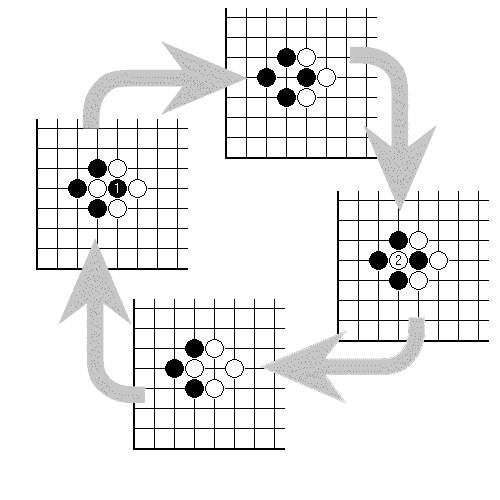

The Go players who gather at Dan's are a peaceable bunch. Quarrels are rare. You could probably provoke an argument if you tried hard, by criticising someone's style on the board. Everyone thinks they play like Manchester United. When it comes down to it, some combine the scruples of Maradona with the excitement of the old Arsenal team.
I think of this on your next visit to Dan's. It turns out that you are now a player, having several wins against a computer program under your belt. The initial cloudiness of the basic Go concepts has cleared up, with a little experience. However, you ask for a tutorial on the ko rule. Can do.

A ko is this type of opportunity for a quarrel. Black 1 takes a single white stone. If there were no special rule, White could then take back the stone Black has just played, and the position would repeat.
This situation resembles nothing so much as two small children, both of whom want to play with the same toy. A parent, seeing the snatching (accompanied by shouts of "Mine!", "No, mine!"), may intervene with another toy as distraction. How it goes then depends on whether the children can agree on who has what, or continue in "I want the one she wants" mode for a while.
So it is with the ko rule. You are not allowed, in fact, to retake immediately, causing a repeat in the position. Therefore you play elsewhere, in such a way as to attract your opponent's attention ("make a ko threat") - assuming the recapture is worth fighting over. If your opponent is more interested in what you have just done,and answers you there, you then have a chance to recapture.
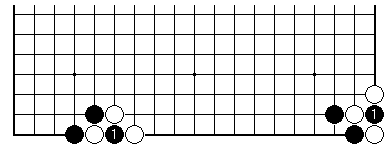
There are other patterns of ko, such as these ones. They involve a capture of a single stone, by a lone stone. Other immediate recaptures aren't subject to the rule.
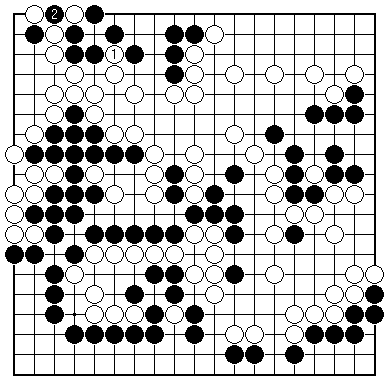
In fact there is a ko in progress: JEEVES is playing TODD, and Black has become involved in quite a serious fight. The players are relative newcomers to the game, so their handling of this situation can be criticised. However you'll get the general idea. Black 2 sets up the ko.
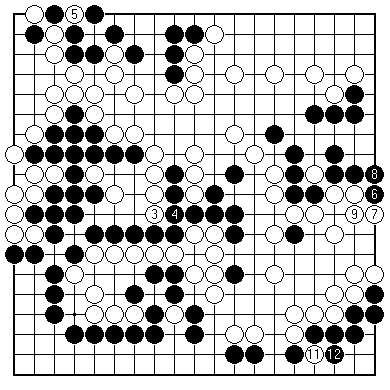
White 3 is a good example of a ko threat. Black answers it: otherwise a White play at 4 would capture not just two black stones, but seven further ones to the right which would be left eyeless and cut off. White now retakes the ko. Black 6 isn't such a good threat. White could easily afford to connect the ko and tell Black "do your worst" on the right side. White's follow-up attack in the top left would be more serious, as perhaps you can see. Black 10 retakes the ko (where Black played 2). Now White 11 is a good threat; Black 12 in answer is arguably a slip leaving a weakness (would be better three to the left, but this would take us further into the realm of counting threats).
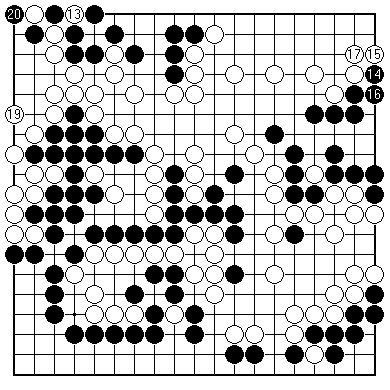
White retakes the ko with 13. After Black plays 14 as a further threat White seems to become dispirited: White 19, in reply when Black recaptures with 18, is just a defensive play. White had further useful threats in the lower right. Black's capture with 20 finishes the ko. White should have been able to profit more from it. For the beginner ko fights go beyond normal play, into an area requiring quite precise judgement of exchanges. No one finds this easy, initially.
Now you really have seen the major rules of Go, and their most important effects. What about other kinds of repetition? They are possible, but are about 1000 times less likely to occur than kos, which are seen in most games. They can lead to draws, under the Japanese rules.
First published 24 February 2000 as On Your Side on MindZine,
Go Learning
© Charles Matthews 2000.